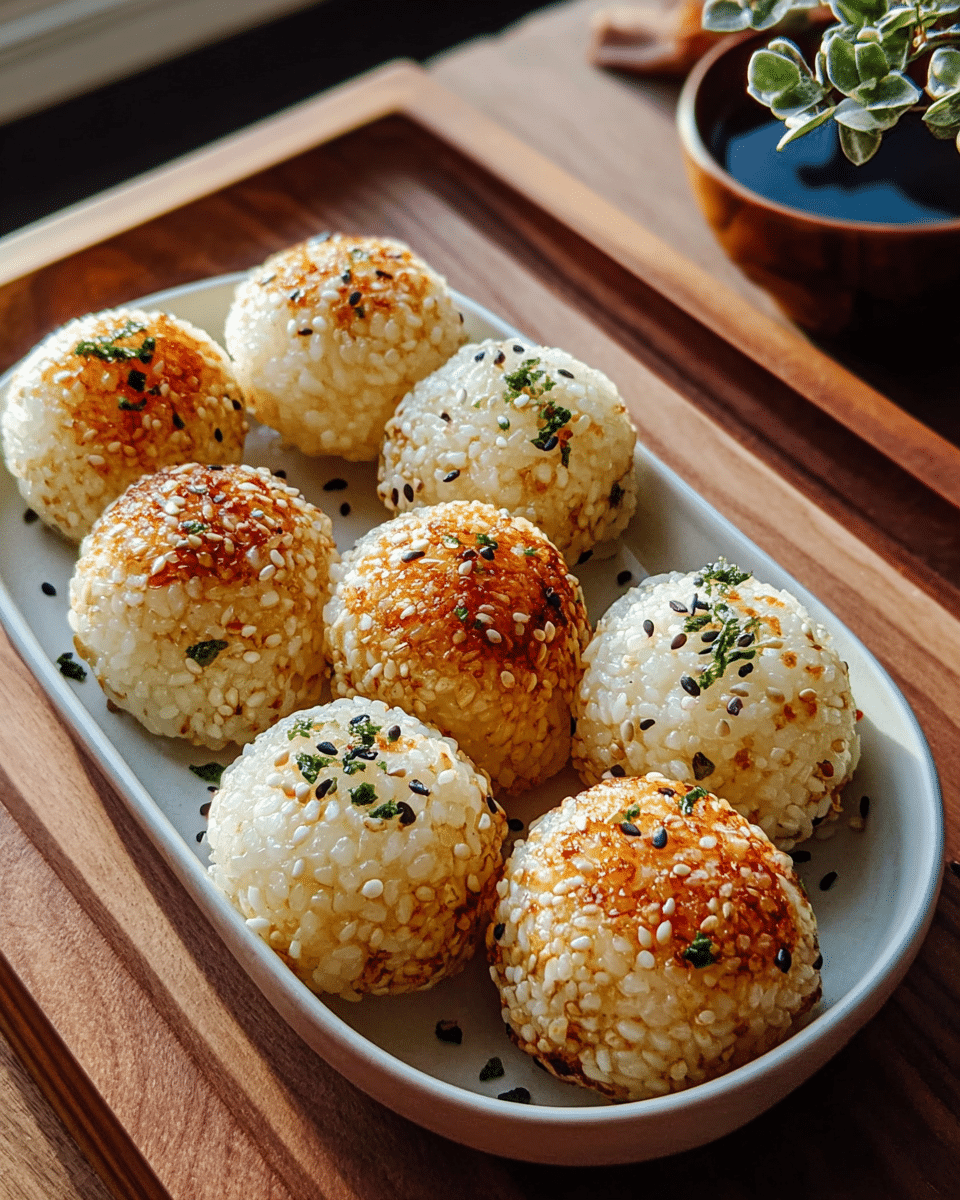Korean Rice Balls (Jumeokbap) are a quick, customizable, and delicious dish that’s perfect for lunchboxes, picnics, or a light snack. These hand-pressed rice balls are filled with a variety of flavorful ingredients like tuna, bulgogi, or kimchi and are seasoned with sesame oil, seaweed, and sesame seeds. They’re easy to make, nutritious, and versatile.
Full Recipe:
Ingredients
For the Rice:
-
2 cups cooked short-grain rice (warm)
-
1 tablespoon sesame oil
-
1/2 teaspoon salt
Filling Options (Choose One or Mix & Match):
-
1/2 cup canned tuna, drained and mixed with 1 tablespoon mayonnaise
-
1/2 cup cooked bulgogi beef, finely chopped
-
1/2 cup finely chopped kimchi (squeeze out excess liquid)
-
1/2 cup shredded cooked chicken with soy sauce
For Seasoning & Coating:
-
2 tablespoons roasted seaweed flakes (gim)
-
1 tablespoon sesame seeds
-
1 teaspoon soy sauce
-
1/2 teaspoon gochugaru (Korean red pepper flakes, optional)
Directions
-
Prepare the Rice: Cook the short-grain rice according to the package instructions. Once cooked, mix in sesame oil and salt while the rice is still warm.
-
Prepare the Filling: Choose your filling (tuna, bulgogi, kimchi, or chicken) and mix it with the rice. If using tuna, mix with mayonnaise; if using bulgogi or chicken, chop it finely.
-
Season the Rice: Add roasted seaweed flakes, sesame seeds, soy sauce, and gochugaru (if using) to the rice mixture. Gently stir everything to combine.
-
Shape the Rice Balls: Wet your hands with water or sesame oil to prevent sticking. Take about 1/4 cup of the rice mixture and press it into a compact ball. Repeat until all the rice is used.
-
Serve or Store: Serve immediately, or wrap the rice balls in plastic wrap for storage. They can be kept in the fridge for up to 24 hours.
Nutrients (Per Rice Ball):
-
Calories: 120 kcal
-
Carbohydrates: 22g
-
Protein: 4g
-
Fat: 3g
-
Fiber: 1g
-
Sugar: 1g
These Korean rice balls are perfect for a quick snack or meal and can easily be customized with your favorite fillings!
The Versatility of Jumeokbap
What makes Jumeokbap so appealing is its incredible versatility. Unlike many other rice dishes, which often require complicated ingredients or preparation, Jumeokbap offers a straightforward approach that allows you to mix and match fillings based on your preferences. Traditional fillings include tuna, bulgogi, kimchi, or even cooked chicken, but the possibilities are endless. You can use any combination of vegetables, proteins, or sauces to create your perfect rice ball.
The beauty of Jumeokbap lies in its adaptability to various dietary needs. It can be made vegetarian by skipping the meat fillings and using a variety of fresh vegetables or tofu. For those looking for a richer option, the addition of seasoned meats like bulgogi or chicken creates a more substantial meal. Additionally, the seasoning used for the rice itself—sesame oil, soy sauce, and sesame seeds—adds a nutty, umami flavor that perfectly complements the fillings.
The Nutritional Benefits of Korean Rice Balls
In addition to being a quick and delicious snack or meal, Jumeokbap is also packed with nutrients. The base of short-grain rice is a great source of carbohydrates, providing the energy your body needs to power through the day. The sesame oil used in the rice adds healthy fats, while the sesame seeds provide a nice crunch and additional nutrients, including calcium and iron.
The fillings you choose can also enhance the nutritional profile of the rice balls. Tuna, for example, is an excellent source of protein and omega-3 fatty acids, which are beneficial for heart health. Bulgogi beef, with its rich umami flavor, offers protein and iron, while kimchi provides probiotics that support gut health. Chicken, when prepared with soy sauce, adds another layer of protein to the mix, making it a versatile choice for those who prefer poultry.
Even with all the variety, each rice ball is relatively low in calories—around 120 kcal per ball—making it a great option for those looking for a lighter meal or snack. With 4 grams of protein and 22 grams of carbohydrates per serving, they offer a good balance of macronutrients to keep you satisfied.
The Key Ingredients in Jumeokbap
While the ingredients may be simple, they are crucial to achieving the right flavor profile. Short-grain rice is the foundation of the dish, as its sticky texture helps the rice balls hold together. Mixing the rice with sesame oil and salt while it’s still warm adds an extra layer of flavor, making the rice base rich and aromatic.
The fillings are where you can get creative. Canned tuna mixed with mayonnaise is a popular filling, providing a creamy, flavorful option. Bulgogi beef, a classic Korean dish made from marinated beef, adds savory, slightly sweet notes to the rice balls. For a more adventurous filling, kimchi brings a spicy, tangy punch that perfectly complements the nutty rice and other ingredients. Cooked chicken, seasoned with soy sauce, offers a more neutral option that can be paired with any of the other flavorings.
The seasoning and coating of Jumeokbap are equally important. Roasted seaweed flakes, or “gim,” are often used to coat the rice balls, giving them a savory, slightly salty edge. Sesame seeds not only add crunch but also enhance the nutty flavor of the sesame oil used in the rice. Soy sauce and gochugaru (Korean red pepper flakes) round out the flavor profile, adding depth and a hint of heat.
How to Make Jumeokbap at Home
Making Korean Rice Balls at home is a fun and easy process. First, you begin by cooking the rice, which serves as the base of the dish. Once the rice is cooked, mixing in sesame oil and salt while it’s still warm ensures that the rice is flavorful from the inside out. After the rice has been seasoned, you can then prepare your filling. Choose from the various options available, such as tuna, bulgogi, kimchi, or chicken, and mix them into the rice. The fillings are what truly make this dish your own, so feel free to experiment with different combinations or add extra ingredients like vegetables or even tofu.
Once the filling is incorporated, the next step is to season the rice mixture with roasted seaweed flakes, sesame seeds, soy sauce, and gochugaru if desired. This adds flavor and texture, making each bite satisfying and full of flavor. After everything is mixed, it’s time to shape the rice into balls. Wetting your hands with water or sesame oil ensures the rice doesn’t stick, allowing you to easily form compact, round rice balls. The rice balls can be served immediately or stored in plastic wrap for later.
Serving Suggestions and Storage
Jumeokbap can be served in a variety of ways. You can enjoy them as a quick snack on the go, pack them in lunchboxes for a tasty and nutritious lunch, or serve them as a side dish to complement other Korean dishes like kimchi stew (kimchi jjigae) or Korean barbecue. They also make a great addition to a picnic, as they’re easy to transport and can be eaten without utensils.
If you have leftovers, Jumeokbap can be wrapped in plastic wrap and stored in the refrigerator for up to 24 hours. Although they’re best enjoyed fresh, they can be eaten cold or at room temperature. If you prefer, you can also reheat them in the microwave for a few seconds, though they are typically enjoyed without reheating.
Conclusion: Why Korean Rice Balls are a Must-Try
Korean Rice Balls (Jumeokbap) are an incredible dish that blends simplicity with flavor. With just a few ingredients, you can create a customizable meal or snack that’s both satisfying and nutritious. Whether you’re looking for a quick lunch or a light snack, Jumeokbap offers endless possibilities in terms of fillings and seasonings, allowing you to tailor each rice ball to your taste.
Not only are they delicious, but they also provide a balanced mix of protein, carbohydrates, and healthy fats, making them an ideal choice for a well-rounded meal. The ease of preparation, combined with their versatility, makes Jumeokbap a staple in many households. Give them a try and explore the many ways you can enjoy these tasty, hand-pressed rice balls!

